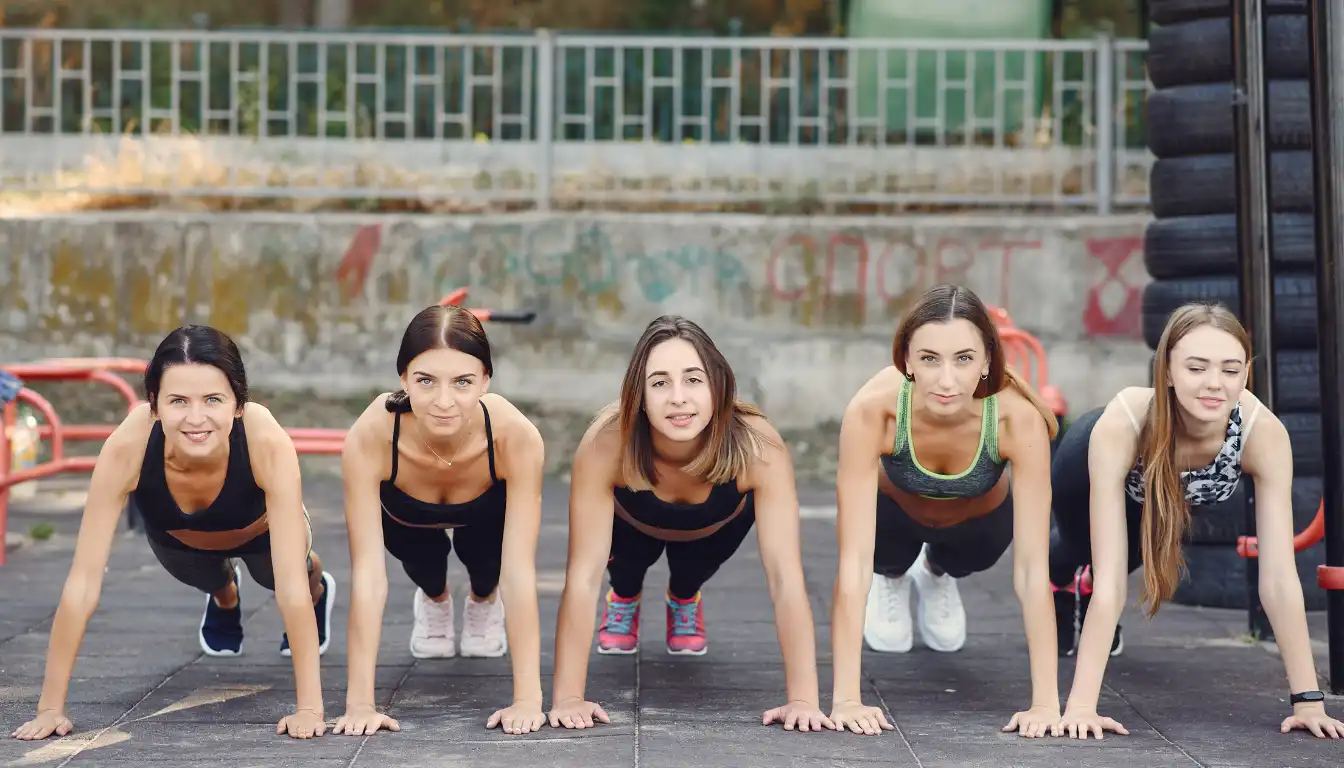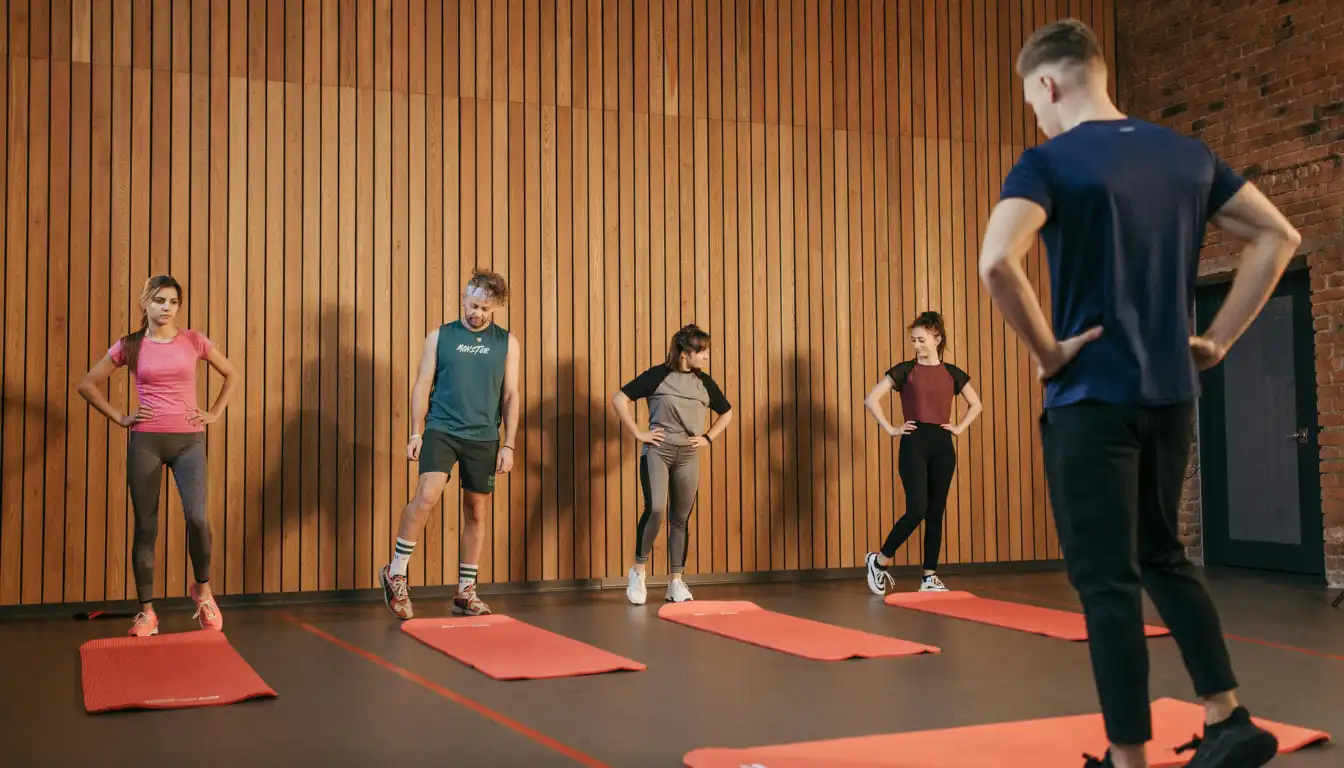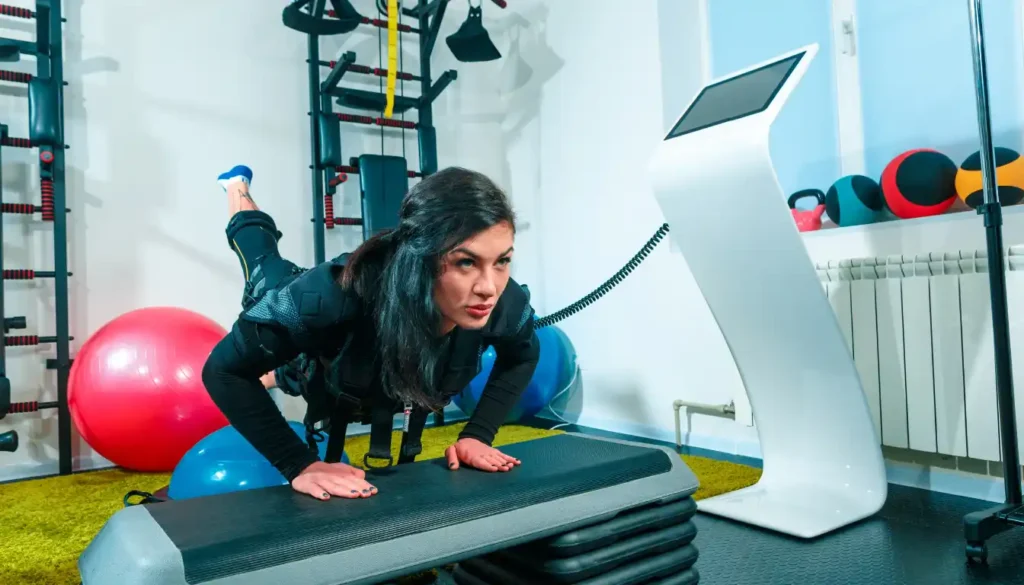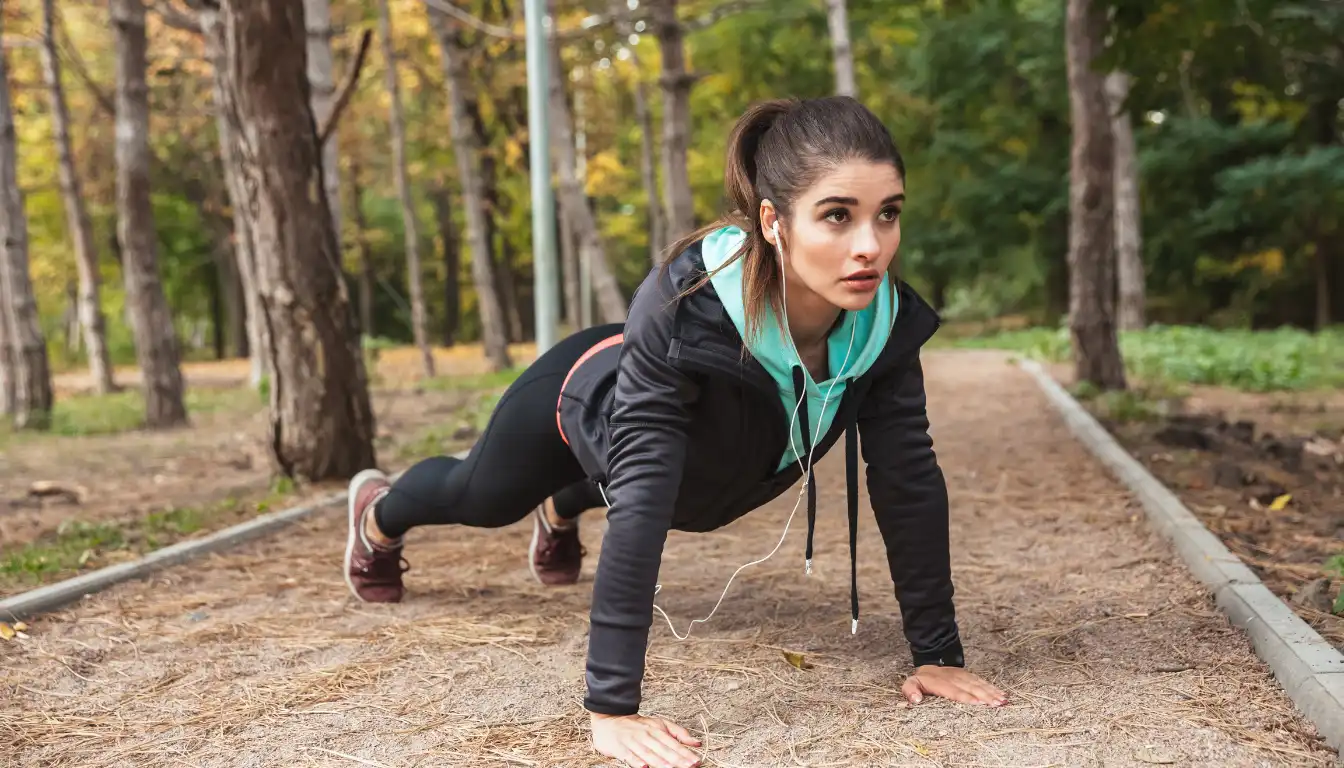I remember my first day at the gym. It was loud and full of strange machines. If you feel the same, you’re in luck. You don’t need a gym to get fit. A women’s beginner bodyweight workout can help you build strength and confidence at home.
As someone who used to love the couch, I’ve found the joy of working out at home. These routines are great for busy women who want to stay healthy without spending much time or money. You’re about to start a female fitness routine that’s both effective and empowering.
Let’s explore a world where you only need your body. Whether you’re a busy mom, a career woman, or someone wanting to feel better, this guide is for you. Get ready to change your body and boost your confidence with easy yet effective moves.
Key Takeaways
- Bodyweight workouts are ideal for beginners, requiring no equipment
- At-home workouts can be as effective as gym sessions for building strength
- A beginner routine typically includes 3 circuits of fundamental exercises
- Aim for 2-4 workout sessions per week with rest days in between
- Proper nutrition and gradual progression are crucial for success
- Exercises can be adapted to suit different fitness levels
Introduction to Bodyweight Training for Women
Bodyweight exercises for women have become very popular lately. As someone who loves fitness, I’ve seen how these workouts change lives. The American College of Sports Medicine says bodyweight training is a top fitness trend. It’s clear why.
Benefits of bodyweight exercises
These workouts work out your whole body at once. They help build strength, improve flexibility, and change your body shape. Let’s look at which muscles get worked in different exercises:
| Exercise | Primary Muscles Targeted | Secondary Muscles |
|---|---|---|
| Push-ups | Chest, Triceps | Shoulders, Core |
| Squats | Quads, Hamstrings | Glutes, Calves |
| Planks | Core | Shoulders, Back |
| Lunges | Quads, Hamstrings | Glutes, Calves |
Why bodyweight workouts are perfect for beginners
Calisthenics are great for beginners. They focus on doing things right to avoid getting hurt. You can change the moves to fit your fitness level. Start with 3 sets of 4-8 reps, then do more as you get stronger.
Equipment-free fitness: Train anywhere, anytime
Working out without equipment is super convenient. You can do it at home, in a park, or anywhere. Try to do 20-30 minute sessions, 2-3 times a week. Don’t forget a 10-minute warm-up and cool-down for best results.
Being consistent is important. With bodyweight training, you’re building a strong base for fitness for life. It’s not about being perfect but making progress. Begin your journey today and see how bodyweight exercises can change you.
Understanding the Fundamentals of Calisthenics
Calisthenics comes from ancient Greek practices and is now a key part of body weight training. It’s easy to start and very effective. This method is great for beginners looking to begin their fitness journey.
Exercises like push-ups, squats, and planks use your weight as resistance. They’re perfect for beginners and don’t need any special gear. You can do these exercises anywhere, making it easy to keep up with your fitness goals.

Studies show that calisthenics is very beneficial. A study in the International Journal of Physiology, Nutrition and Physical Education found it better than yoga and Pilates in lowering cholesterol and weight. This shows it can improve your overall health.
For women starting strength training, bodyweight exercises are a good choice. Start with one set of 10 bodyweight squats to work many muscles. Then, add exercises like plank push-ups and burpees to target different body areas.
| Exercise | Sets/Reps | Target Areas |
|---|---|---|
| Bodyweight Squats | 1 set of 10 | Thighs, Hamstrings, Glutes, Core |
| Plank Push-ups | 1 set of 10 + 20s plank | Arms, Chest, Shoulders, Core |
| Burpees | 2 sets of 4 | Full Body |
Being consistent is important in calisthenics. Regular practice will help you get stronger, more flexible, and fitter. As you get better at basic moves, you can try harder exercises like pull-ups. This will help you reach new fitness goals.
Setting Realistic Fitness Goals for Beginners
Starting a fitness journey can be exciting yet daunting. As a beginner, I’ve learned that setting realistic fitness goals is key to success. It’s not just about the result but the journey itself.

Short-term vs. Long-term Objectives
I’ve found that balancing short-term and long-term goals keeps me motivated. Short-term goals might include mastering proper form for basic exercises, while long-term goals focus on overall strength and endurance improvements.
| Short-term Goals | Long-term Goals |
|---|---|
| Perform 5 quality pushups | Run a 5K in 3 months |
| Hold a plank for 30 seconds | Achieve 20 bodyweight squats in a minute |
| Stretch or do yoga twice a week | Lower resting heart rate by 5 bpm |
Tracking Progress and Celebrating Milestones
Workout progress tracking is crucial for staying on course. I use a fitness app to log my workouts and monitor improvements. Celebrating each fitness milestone, no matter how small keeps me motivated and committed to my routine.
Adapting Goals as You Advance
As my fitness level improves, I adjust my goals. I might increase the number of workout days from 3 to 4 per week or incorporate new exercises. Listening to my body and being flexible with my objectives ensures continued progress without risking burnout or injury.
Read: 7 Powerful Daily Exercises For Health And Energy Boost
Remember, consistency is key in any fitness journey. By setting achievable goals, tracking progress, and celebrating milestones, you’ll be well on your way to a healthier, stronger you.
Proper Form and Technique: The Foundation of Effective Workouts

Are you starting a bodyweight workout routine? Mastering the correct technique is key. It’s the foundation of your fitness journey. Let’s explore why proper form is crucial and how to get it right.
Proper exercise form is not just about looking good. It’s about staying safe and working out effectively. Doing exercises correctly lowers injury risk and targets the right muscles. This is vital as we age, losing muscle mass at 3-5% per decade from 30 onwards.
To get the beginner exercise form right, follow these tips:
- Focus on body alignment
- Control your movements
- Use mirrors or video recordings to check your form
- Start with basic exercises and progress gradually
Now, let’s check out some popular exercises and their correct form:
| Exercise | Key Form Points |
|---|---|
| Push-ups | Hands shoulder-width apart, body straight, lower chest to ground |
| Squats | Feet hip-width apart, knees track over toes, chest up |
| Planks | Straight line from head to heels, engage core, shoulders over wrists |
It’s better to do fewer reps with perfect form than many with poor technique. Focus on proper exercise form from the start. This builds a strong foundation for your fitness journey and leads to better results over time.
Women’s Beginner Bodyweight Workout Routine
I’m excited to share a beginner full-body workout perfect for women starting their fitness journey. This workout can be done anywhere, anytime, making it great for busy schedules.
Warm-up Exercises
Before starting the main workout, it’s important to warm up. Begin with 5-10 minutes of light cardio like jogging in place or jumping jacks. Then, do dynamic stretches to get your muscles ready.
Core Workout Components
This women’s workout plan focuses on all major muscle groups. Here’s what the routine includes:
| Exercise | Sets | Reps/Duration |
|---|---|---|
| Bodyweight Squats | 3 | 8-10 |
| Lunges | 3 | 8-10 (each leg) |
| Push-ups | 3 | 8-10 |
| Glute Bridges | 3 | 10-12 |
| Plank | 3 | 15-45 seconds |
Do each exercise for 45 seconds, then rest for 15 seconds. This 20-minute routine is great for beginners. It helps with strength, muscle growth, and weight loss.
Cool-down and Stretching
Finish your workout with 5-10 minutes of static stretching. This improves flexibility and reduces muscle soreness. Breathe deeply and hold each stretch for 15-30 seconds.
Start with this routine 1-2 times a week, then increase to 3 times a week on non-consecutive days. Stick with it for 8-12 weeks to see real fitness progress!
Essential Bodyweight Exercises for Women
Bodyweight exercises are great for working out at home. They’re perfect for beginners and help build strength. Let’s look at key exercises that work many muscle groups and suit different fitness levels.
Push-ups and Variations
Push-ups are key in bodyweight training. Beginners can start with knee push-ups or incline push-ups against a wall. As strength grows, move to standard push-ups. Do 3 sets of 10-12 reps, focusing on good form.
Squats and Lunges
Squats and lunges are great for the lower body. Start with bodyweight squats, making sure knees don’t go past toes. Move to reverse lunges, then walking lunges as you get stronger. Do 3 sets of 10-12 reps for each.

Planks and Core Strengtheners
Planks are key for a strong core. Begin with a 20-second hold and increase it over time. Add side planks and mountain climbers for variety. For a dynamic core workout, try bicycle crunches and Russian twists.
| Exercise | Sets | Reps/Duration | Target Area |
|---|---|---|---|
| Push-ups | 3 | 10-12 | Chest, Arms, Core |
| Squats | 3 | 10-12 | Legs, Glutes |
| Lunges | 3 | 10-12 (each leg) | Legs, Glutes |
| Plank | 3 | 20-30 seconds | Core, Full Body |
| Bicycle Crunches | 3 | 20 | Core, Obliques |
Always focus on proper form in each exercise. Start with 2-3 workouts a week, resting on other days. As you get better, increase reps, sets, or try harder versions to boost your strength and fitness.
Progression Strategies: Advancing Your Workout
Bodyweight exercise progression is vital for ongoing improvement in calisthenics. As you get stronger, it’s important to try harder exercises.
I began with wall push-ups, then moved to incline push-ups, and now do standard push-ups. Squats went from assisted to doing them on my own, and I’ve added jump squats for more challenge. Pull-ups started with Australian pull-ups and moved to full pull-ups.
Improving your workout isn’t just about doing more reps. I focus on perfecting my form and tension. For example, I hold isometric planks for 10-20 seconds, then move to straight arm planks and one-arm-one-leg planks.
Here’s a sample progression strategy for calisthenics:
| Exercise | Beginner | Intermediate | Advanced |
|---|---|---|---|
| Push-ups | Wall push-ups | Standard push-ups | One-arm push-ups |
| Squats | Assisted squats | Bodyweight squats | Pistol squats |
| Core | Planks | Hollow holds | Handstand holds |
Regular challenges help avoid plateaus and keep you moving forward in your calisthenics journey.
Nutrition Tips to Complement Your Bodyweight Training
Nutrition is key to reaching your fitness goals with bodyweight training. The right food can boost your workout performance and help you recover. Let’s explore some important nutrition tips to improve your training.
Balanced Meal Planning
It’s vital to plan your meals well for bodyweight workouts. The USDA says to eat half your plate with fruits and veggies at meals. For energy, aim for 45-65% of daily calories from carbs, the Mayo Clinic advises.
Don’t forget about protein. Adults need about 0.36 grams of protein per pound of body weight every day.

Hydration Importance
Drinking enough water is crucial for your workouts. I always drink water before, during, and after exercising. Staying hydrated helps keep your energy up, controls body temperature, and supports recovery.
Pre and Post-Workout Nutrition
What you eat before and after workouts is crucial. For muscle gain and strength, eat 14-18 calories per pound of body weight. If you’re focusing on fat loss, aim for 10-12 calories per pound.
After your workout, eat a mix of carbs and protein. Aim for 50 grams of carbs and 25 grams of protein in a 2-to-1 ratio.
| Goal | Calorie Intake | Protein | Fat | Carbs |
|---|---|---|---|---|
| Muscle Gain | 14-18 cal/lb | 1-1.5 g/lb | 0.4 g/lb | 2 g/lb |
| Fat Loss | 10-12 cal/lb | 1-1.5 g/lb | 0.4 g/lb | 1 g/lb |
Being consistent is important. Allow yourself one or two cheat meals a week to stay on track with healthy eating. By following these tips, you’ll support your bodyweight training and reach your fitness goals.
Overcoming Common Challenges and Staying Motivated
Setting specific goals is crucial to beat fitness plateaus. It helps me track my progress and stay focused. Having both short-term and long-term goals keeps me moving forward.
Personal reasons for getting fit keep me committed. Finding a deeper purpose makes challenges easier to handle. Mixing up my workouts keeps things interesting and helps me improve.
Having a workout buddy makes me more accountable and sessions more fun. This keeps me motivated.
Anthony Arvanitakis’s story shows how consistent exercise can change lives. After a serious accident, he started bodyweight training for surgery. His story proves that with determination, you can beat fitness plateaus.
Consistent exercise habits are key for lasting success. Celebrating small victories and focusing on your goals helps you stay motivated. This way, you can overcome challenges and keep going on your fitness path.
“This article is not medical advice. Always speak to a medical professional before starting any new exercise regimen to ensure it is right for you. This post may contain affiliate links.”






